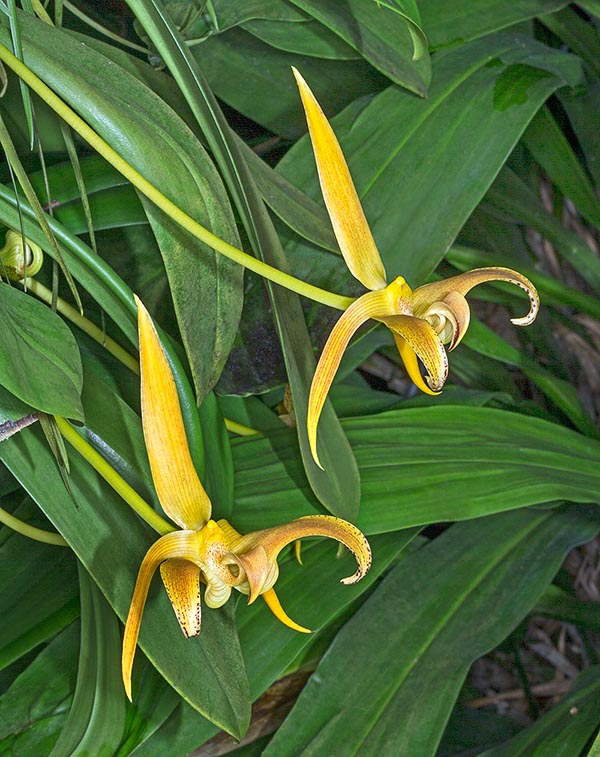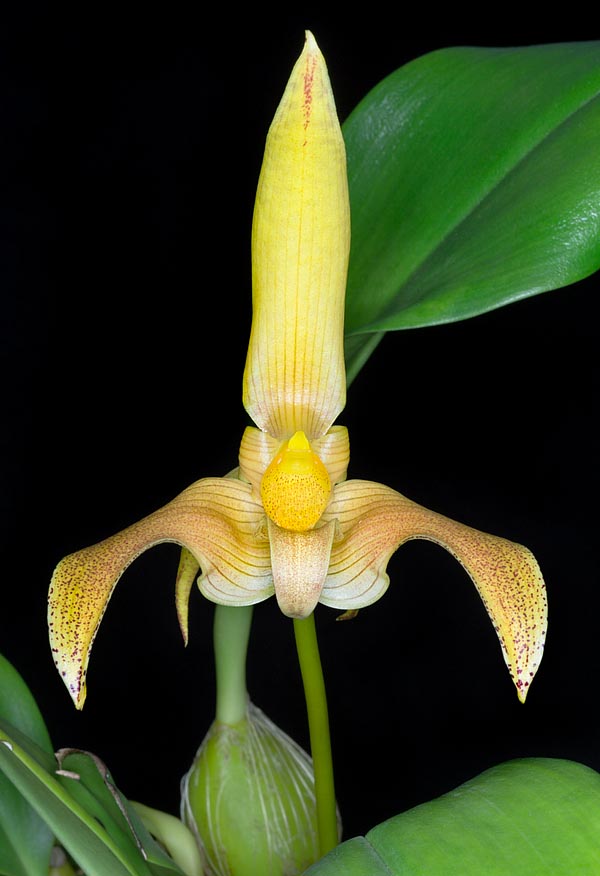Family : Orchidaceae

Text © Pietro Puccio

English translation by Mario Beltramini

South-East Asian epiphyte, the Bulbophyllum lobbii has inflorescences borne by solid 10-15 cm peduncles © Giuseppe Mazza
The name of the genus is the combination of the Greek substantives “βολβός” (bolbos) = bulb and “φύλλον” (phyllon) = leaf, with reference to the leaves that grow at the apex of the pseudobulbs; the species is honoured to the English collector Thomas Lobb (1817-1894).
Common names: Lobb’s bulbophyllum (English); lin fa (Thai).
The Bulbophyllum lobbii Lindl. (1847) is an epiphytic species rather variable for size and for colour of the flowers, with creeping rhizome, of 0,4-0,6 cm of diameter, rooting at the nodes spaced about 1 cm.
Ovoidal pseudobulbs, spaced 3-6 cm, 3-5 cm long and of 2-3 cm of diameter, provided at the apex of one single obovate-oblong leaf with obtuse apex, 12-26 cm long and 4-7 cm broad, of pale green colour, coriaceous.
Inflorescence, on a 10-15 cm long peduncle, from the node at the base of the pseudobulb, as well as from the nodes along the rhizome, bearing one single flower, of 6-9 cm of diameter, waxy, pleasantly scented, with sepals and petals of variable colour, pale yellow to reddish yellow with pale purple brown longitudinal veins and dottings of the same colour thicker towards the apex.
Erect dorsal sepal, oblong-lanceolate with acuminate apex, 4-5 cm long and 1-1,2 cm broad, ovate-lanceolate lateral sepals with curved acute apex, falcate, retroflexed, lanceolate petals with acuminate apex, 3-7 cm long, more or less retroflexed, ovate mobile labellum with curved acute apex, 0,8-1 cm long and 0,5-0,7 cm broad.
It reproduces by seed, in vitro, and by division, with each section provided of at least 3-4 pseudobulbs.

The waxy, pleasantly scented, flower lasts 2 weeks and reaches the 9 cm of diameter. Easy cultivation © Giuseppe Mazza
It requires a semi-shaded position, intermediate temperatures, with day values of 22-30 °C and night ones of 14-18 °C, constant high humidity, 70-85%, and air in continuous movement.
Regular waterings and nebulizations during the growth period, but without stagnations, in particular during the first stage of development of the new pseudobulbs, easily subject to rottenness, more spaced during the vegetative rest, but without ever allowing to dry up completely, utilizing rain water, demineralized or by reverse osmosis at ambient temperature.
Monthly fertilizations with a hydrosoluble balanced product, with microelements, at 1/5 the dosage shown on the package, duly alternated to the waterings, being the roots quite sensitive to the salts accumulations.
It can be cultivated in pots or baskets, with a compost formed by medium sliced bark fragments and sphagnum as well as mounted on trunks, pieces of bark or rafts of arborescent ferns roots with sphagnum at the base.
It does not appreciate to be disturbed, therefore repottings and divisions are to be done when strictly necessary at the vegetative restart.
The species is reported in the appendix II of the CITES (species whose trade is internationally ruled).
Synonyms: Sestochilos uniflorum Breda (1828); Sarcopodium lobbii (Lindl.) Lindl. & Paxton (1851); Bulbophyllum henshallii Lindl. (1852); Sarcobodium lobbii (Lindl.) Beer (1854); Bulbophyllum siamense Rchb.f. (1867); Phyllorchis lobbii (Lindl.) Kuntze (1891); Phyllorkis lobbii (Lindl.) Kuntze (1891); Bulbophyllum claptonense Rolfe (1905); Bulbophyllum polystictum Ridl. (1909); Bulbophyllum sumatranum Garay, Hamer & Siegerist (1996).
→ For general notions about ORCHIDACEAE please click here.
